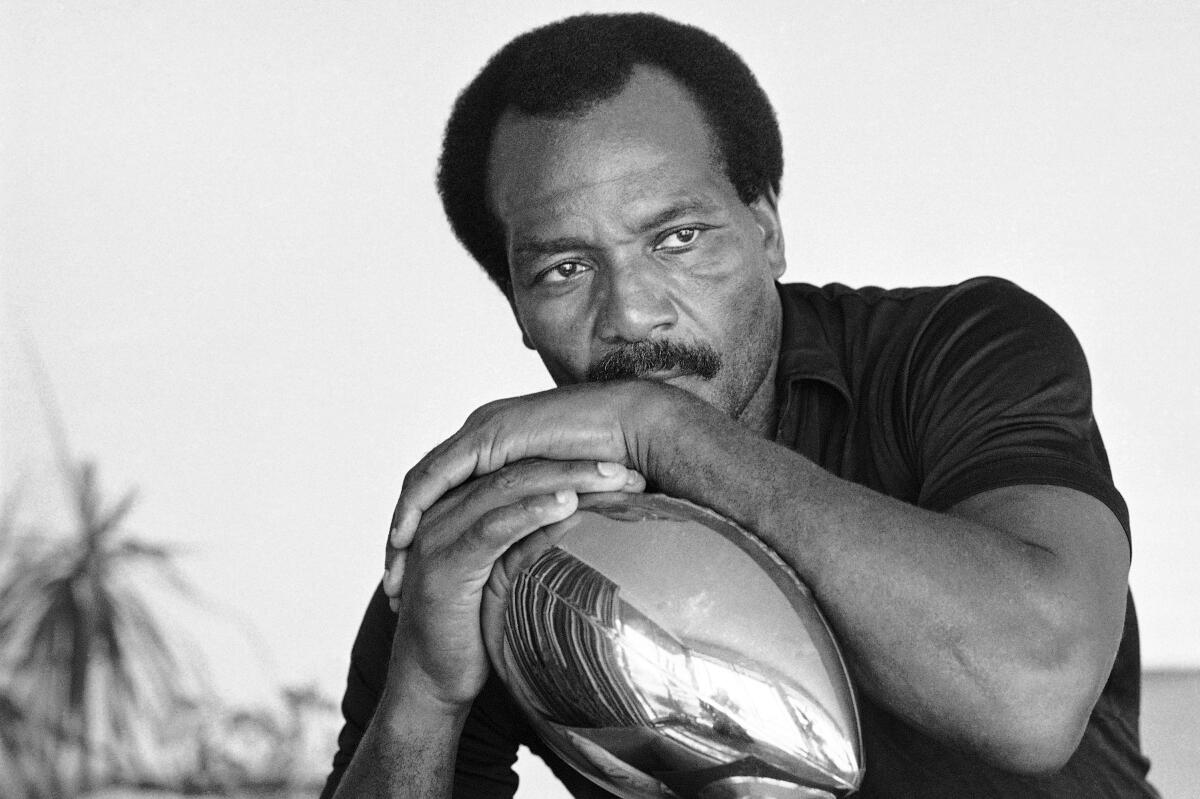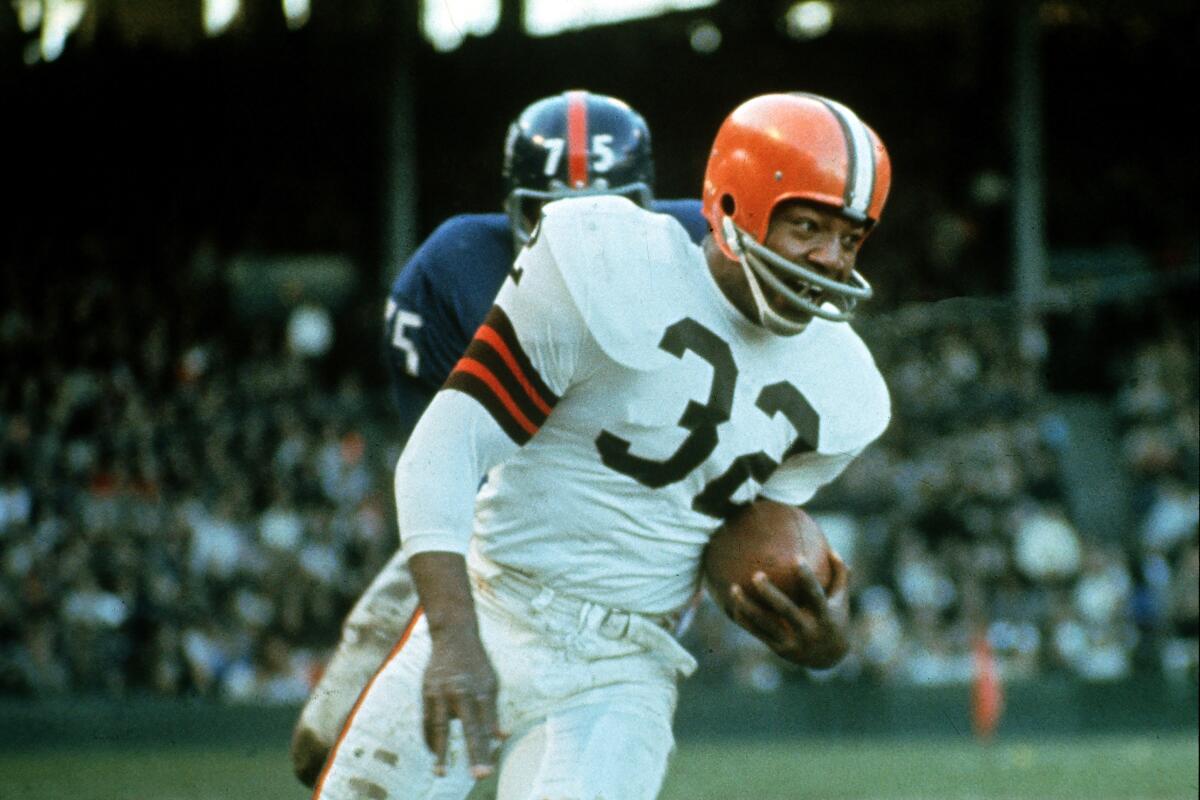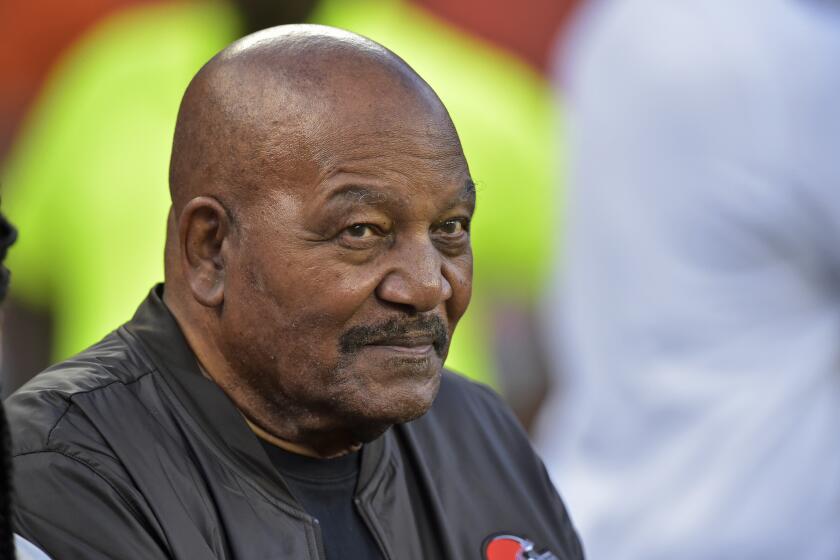For all his accomplishments, NFL legend Jim Brown leaves a highly flawed legacy

- Share via
When I interviewed Jim Brown 10 years ago, he had an agenda and so did I. They were not the same agenda.
When he died Friday in Los Angeles, at age 87, I pondered that interview, that day in a quiet restaurant in West Hollywood, where this mostly brooding man, dressed all in black, spoke in grunts and grumbles.
He was there to get something in the paper about a cause he was championing. It was called the Common Good Fund. Its purpose was to get money from the NFL as the result of a lawsuit filed by several retired players, led by the Rams’ Fred Dryer. They said the league had not compensated players for use of their images in ads and promotions. If the court said yes to the NFL needing to cough up $42 million, which it eventually did, Brown would be in charge of identifying and distributing money to older retired players in need.
He said he liked the plan because he and other NFL players in his group would be able to get the money to the right people. Even some of those “right” people of former NFL players didn’t agree. Many thought the NFL was paying up to shut them up, especially since this was the era when the league was being besieged by one concussion scandal after another.
A year earlier, the Chargers’ Junior Seau, age 43, tortured by the brain-damaged effects of chronic traumatic encephalopathy, had shot himself in the chest so his family would have an undamaged brain to use for testing. His family did and the diagnosis was CTE.
Skeptics felt if the NFL wrote this big check quickly and had a nice news conference with Brown standing side-by-side with Commissioner Roger Goodell, the media would move on the next day, maybe slow down the concussion stories. That’s pretty much what happened. With the NFL, it is ever thus.

My agenda that day in the interview was related but different. I had an audience with one of the greatest, toughest, most intimidating players in the history of the game, a man who was an All-American running back at Syracuse — a consensus All-American there — and one of the greatest carriers of a football for all his nine years with the NFL’s Cleveland Browns.
Would he talk about the brutality of the game, about the trend among parents to push their young male athletes toward baseball or basketball those days, fearing serious injury?
I had a specific talking point. I had recently read a book by Mark Kram about a high school football player from Philadelphia named Buddy Miley, who was a star quarterback until the day he was tackled hard and was left paralyzed. Kram wrote about how his family took turns brushing pestering flies off Miley’s face, because Miley couldn’t. Miley eventually died in a room in a Quality Inn Hotel in Michigan, where he had gone to meet “Dr. Death,” Jack Kevorkian, who helped him die by suicide.
I put injuries and football brutality on the table. Brown answered with macho.
“You’re gonna be tested, tested in life,” he said. “I tested myself and it made me a better man.”
He said he had six grandsons, all played football and he never worried about any of them.
“My most serious injury was a twisted ankle,” he said.
NFL legend Jim Brown, who quit the game and became a successful Hollywood actor and influential civil rights activist, has died in Los Angeles at 87.
I doubted that, but I realized even though he was taking up the cause of some fellow NFL players, he could never stop being what he was: rugged, intimidating, 100% testosterone. From that, he had created individual greatness in football and a long career in movies, usually as an actor in the role of somebody rugged and intimidating. Think of him as a less-talented Arnold Schwarzenegger.
His was a life of incomparable peaks and valleys.
Bob Arum, Hall of Fame boxing promoter, loves to tell the story about how he and Brown became friends. Arum was a lawyer for a big, fancy firm in New York City in 1965, and a friend was involved in putting on a heavyweight fight between Ernie Terrell and George Chuvalo. The fight was drawing no interest. Tickets were gathering dust in the box office. The friend asked Arum, who at that point knew little about the sport and cared less, what he could do to hype it up. As years have shown, Arum is the king of “hyping it up.”
Arum told him there had never been a black announcer doing a fight broadcast ringside. That would open up an entire new market, he reasoned. They tried Willie Mays. He was busy. They called Jim Brown. He said yes. They announced his presence and tickets began to move.
Arum watched the fight and Brown’s work from a broadcast trailer nearby. Afterward, Brown came to see how he had done, and in their ensuing conversations, Brown, sensing a promoter’s skill in Arum, remarked that Arum was wasting his time with a bunch of stuffy lawyers in a big office building when he could be putting on the fights himself.
Arum told him he didn’t know anything about boxing, didn’t like the sport, and certainly wouldn’t take that on unless he could promote the only fighter who mattered in those days, Muhammad Ali. A few weeks later, Brown called him, took him to meet Ali, and the rest is history.
To this day, Arum would tell you Brown was a great friend. So will many in sports, but most of them will be male.
Along the way, Brown has become both sports legend and negative headline-grabber.

Samples: He once hit and choked a golfing companion, the police came and he was eventually charged with assault. He once used a shovel to smash the window of one of his wife’s cars. Diane K. Shah, who had written sports for the Los Angeles Herald Examiner and now is a well-known author of books, once went to interview Brown at his home overlooking the Pacific Ocean. She met a very young woman who was Brown’s girlfriend at the time and who told Shah what a great guy he was. A few months later, the young girl was calling police from a locked bathroom in the house, fearing more violence from Brown.
Then there was the one that stuck with Brown, the accusation that he had thrown model Eva Bohn-Chin off a balcony in Los Angeles in the middle of a fight they were having. She soon said that the police charge that she was thrown off the balcony was wrong. Later, she would do an interview, show the questioner some bruises and ask, rhetorically, “Would I have thrown myself off the balcony?”
How will Brown be remembered?
In his prime, he was a tireless advocate for civil rights. He saw mistreatment of Black people, spoke out about it and organized groups to address it.
So, the obvious summation is to say that the great Jim Brown, wonderful athlete, decent movie star and terrible human being to many women, is an enigma. So many who knew him liked him. So many, the majority of those women, did not. Was he a charmer or a bully? Will highlight films of great NFL running plays overshadow his rap sheet?
When most celebrities die, there is a consensus of feeling and an outpouring of that. With Jim Brown, that’s not so.
More to Read
Go beyond the scoreboard
Get the latest on L.A.'s teams in the daily Sports Report newsletter.
You may occasionally receive promotional content from the Los Angeles Times.











